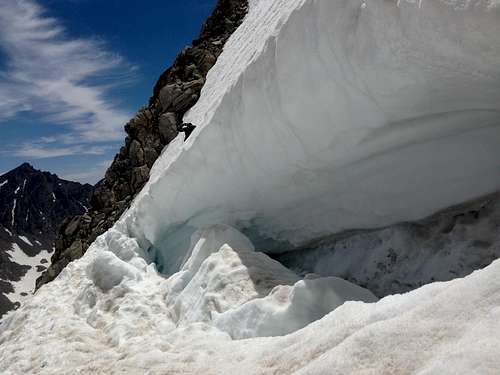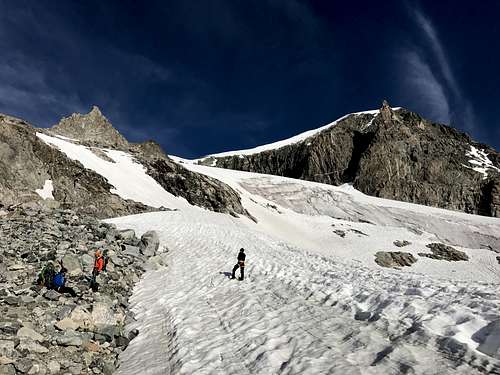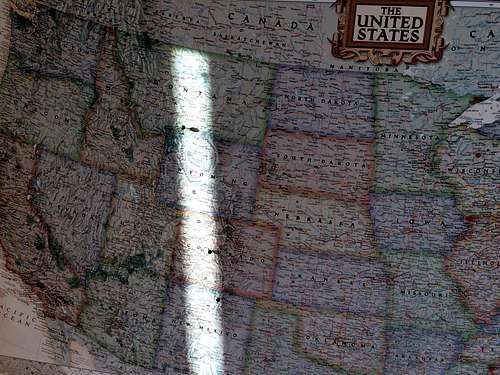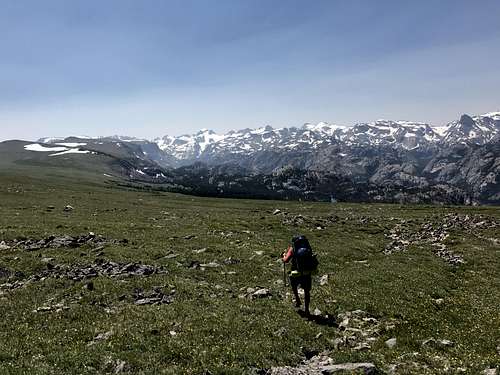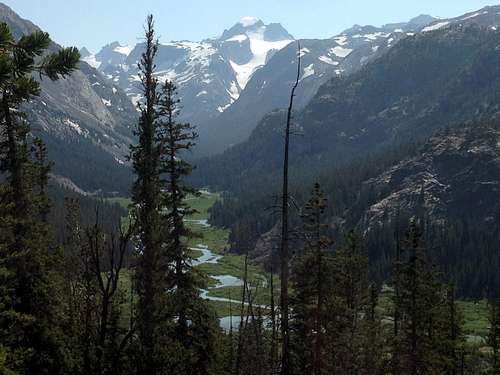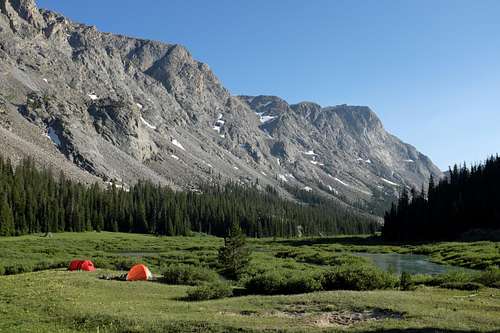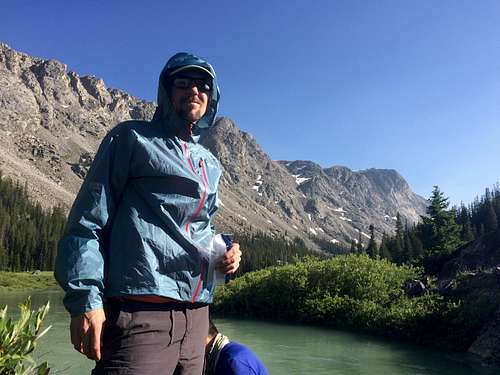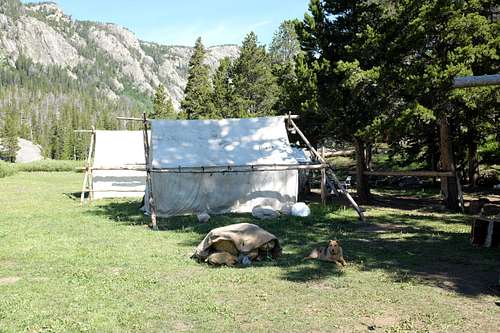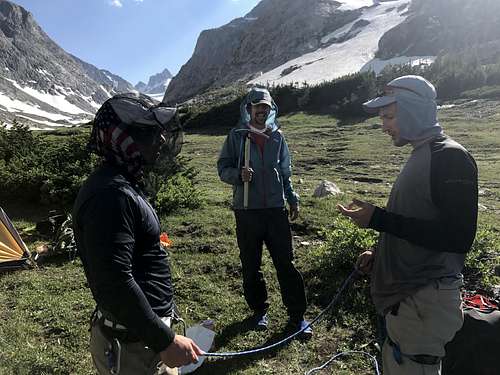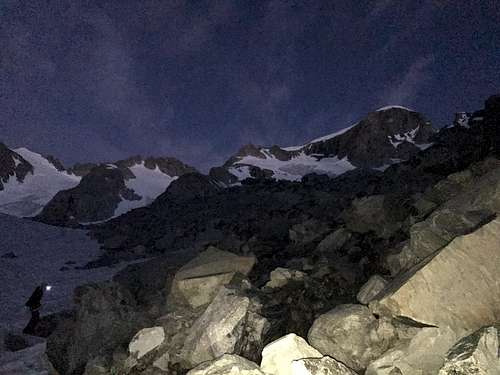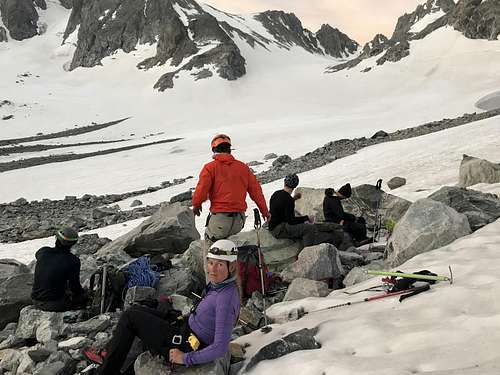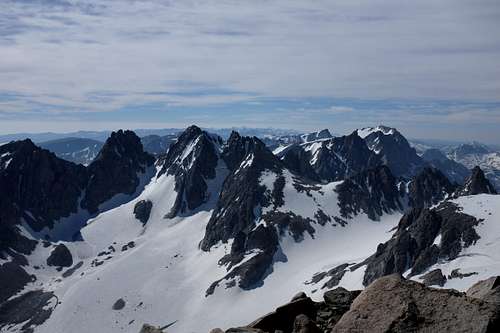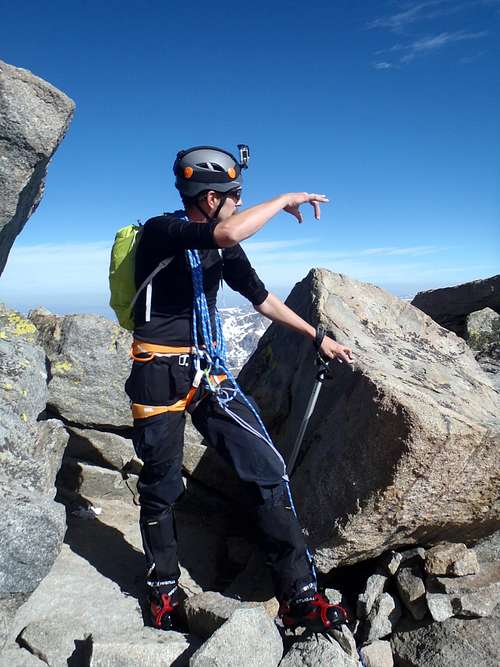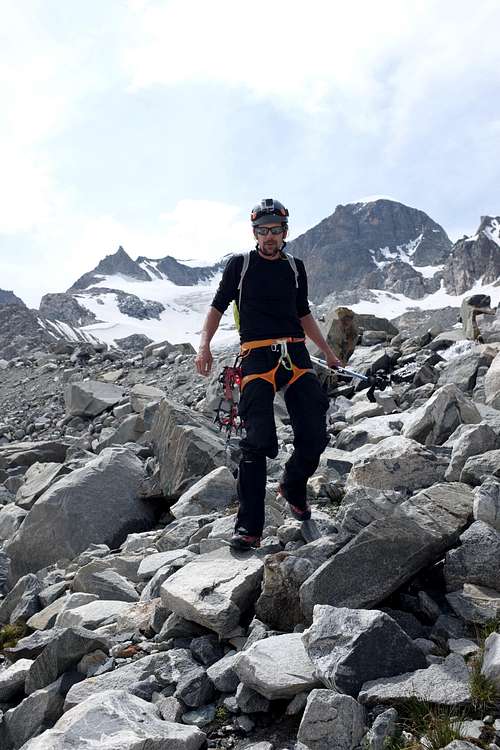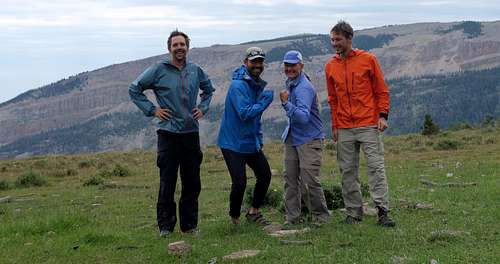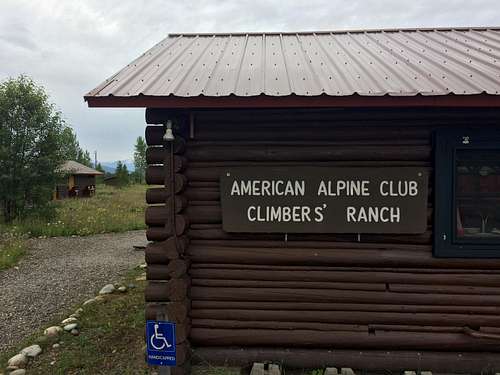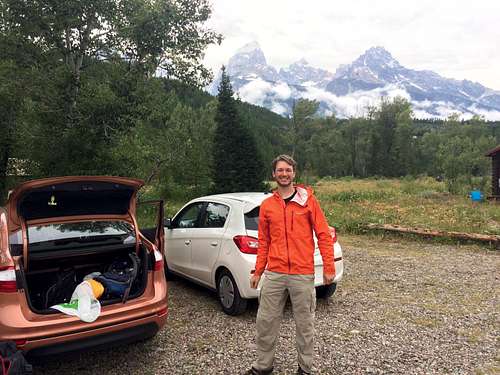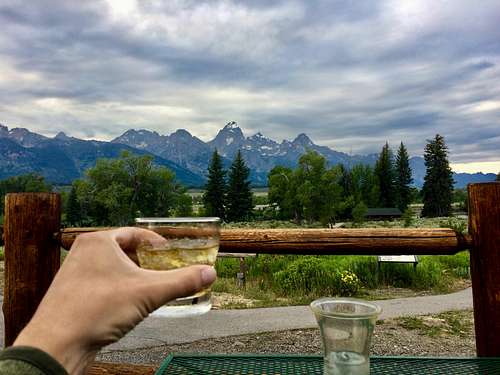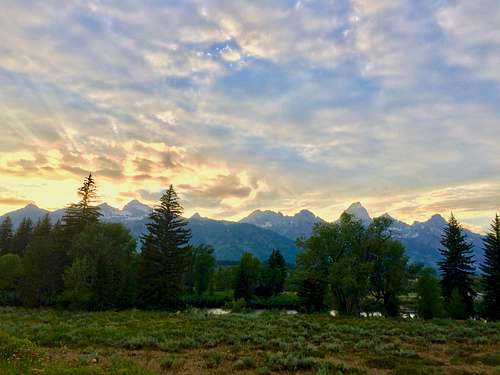-
 4073 Hits
4073 Hits
-
 71.06% Score
71.06% Score
-
 1 Votes
1 Votes
|
|
Trip Report |
|---|---|
|
|
43.18577°N / 109.64642°W |
|
|
Jul 23, 2017 |
|
|
Mountaineering |
|
|
Summer |
Through the Needle of the Snow Mosquito, Ink Wells Trail in July
We were approaching the bergschrund, where the blue glacier had split apart. The snow bridge across it looked sturdy, but I wasn’t excited about being the first to go over it. If it collapsed and San Jose Ryan couldn’t self-arrest, I would die.
The five other climbers were nowhere to be seen, and it was time for another decision, as every moment was critical. San Jose Ryan closed the 10-meter-glacier-travel rope distance between us so I could hear and talk to him.
“If we go on without them, we should leave the rope. We don’t need it,” I said to him.
“[Boston] Will is having trouble with the altitude and [Florida] Jimmy can join the other team if he fixes his crampons. We might need the rope, later. We have to keep going, NOW! It is already so late,” San Jose Ryan said. He was a super-skinny 6-footer and was beyond stubborn, especially while climbing, which helped him be successful.
20 minutes earlier we broke up the rope team, and I had told Boston Will to meet us at this spot and we would see about roping up again. But they hadn’t even started up the Gooseneck Glacier yet when we got to the bergschrund. And going up to the Gooseneck Pinnacle was semi-steep, so doing a glacier rope distance wouldn’t make any sense, anyway. If the climber in front of you fell for 10 meters, good chance, even with your ice axe anchored into the snow, they would rip you right off the mountain with them. And down into the abyss you would slide.
If you must rope up on steep sections, it is best to “short rope,” so you can prevent a slip from becoming a fall. Based on what I saw during the first half hour of the climb, no chance I would short rope with anyone on that mountain outside of Idaho Terri and San Jose Ryan. Mastering crampon steps is no different than dribbling a ball or driving a car—it takes years of practice to be serviceable let alone to per-fect. And Gannett Peak is like the 405 Freeway in LA and probably not the best place to sharpen your skills.
Time was the biggest issue. I wanted to be on the summit no later than 9 a.m. and set a hard turnaround time for 10 a.m. In retrospect, I wish I had been very clear about this before our 7-person group set out at 4 a.m. that morning. But I thought I had. That was the whole reason we were hiking with headlamps and no moon over the boulders and rivers hidden beneath snow in the deep gullies of the Wind River Mountain Range—to beat the melt. Extremely dangerous to be hiking around on a glacier in 50 degrees in the middle of summer—snow becomes slush, avalanche danger, crevasses open up, footing sucks, storms roll in during late mornings and early afternoons—the list goes on and on. Turnaround times are a must in mountaineering.
Florida Jimmy kept having extremely bad luck with his crampons and they kept failing and falling off. He had used them on Mt. Rainier without issue. Outside of your axe, crampons are the most important piece of gear on the mountain. If you don’t have sure footing, you can’t climb. I spent a lot of time with Florida Jimmy, and I believe I made a new friend. He let me sleep in his tent and was awesome throughout the entirety of the experience. I know he felt really bad about his situation even though it was out of his control.
Misfortune also hit Boston Will, as the altitude was really affecting him during the early goings. His footwork just wasn't right. We took numerous breaks to try to fix issues, but every couple of minutes I would get jerked back by San Jose Ryan, who was getting jerked back by Boston Will, who was sometimes doing the jerking and sometimes getting jerked back by Florida Jimmy. Every time we stopped, I would yell back, “Hey, we have to keep our pace. We can’t keep stopping.” San Jose Ryan was getting pretty pissed. He even went down to help Florida Jimmy tie his crampons at one point. But we… just… kept… taking... breaks.
Before we started climbing, it’s true, I did reassure Boston Will that even if the altitude started affecting him, we’d slow down and get him right. But after 3 or 4 breaks without improvement, it would have been irresponsible to take a climber showing signs of altitude sickness, higher. Who knows about HAPE and HACE as well? Further, because of the rope distance, messages had to be passed up the line. I was told by San Jose Ryan that Boston Will "was still struggling with the altitude," which puts someone at risk of full-blown mountain sickness if they go even higher.
The real regret I have is that I didn’t communicate with the other 3-person rope team about what was happening. I should have waited for them below the bergschrund and said, We are going on without roping up all together.
Instead, driven by the fear of the melt, we just charged ahead, up the steep slope to the Gooseneck Pinnacle, the distinct chimney rock formation above the bergschrund.
While we were climbing up to the Pinnacle, Boston Will and Florida Jimmy proceeded up the snowfield leading to the start of the Gooseneck Glacier. About half way up that snowfield they didn’t feel safe and stopped. Eventually the 3-person team caught up and they joined them.
We had a group chat on Facebook leading up to the climb, and I wrote numerous times that if you can’t solo the mountain, you shouldn’t be on it without a guide. What if San Jose Ryan got sick or I got hurt or Idaho Terri went on ahead? It’s called the “halo effect,” where you think the more experienced climber or guide will take care of you from the top to the bottom.
There was about to be a serious confrontation on the mountain as all paths were destined to cross, everyone armed with ice axes and sharp metal knives on their feet.
3 Months Earlier
The hardest thing is trying to explain to people how insane the planning and logistics are leading up to the climb. That’s where all the work and suffering really exists if you are doing it without a guide service company.
A couple of the guys from last year’s Granite Peak climb had been talking about doing Gannett this year, but nothing was ever set in stone. I messed up my Achilles tendon pretty good on Granite and it never recovered. That was my excuse. In March, however, I finally made a doctor’s appointment (that cost me $625 out of pocket even with great insurance! Thanks, Trump!). The X-ray revealed that I wouldn’t need surgery, but physical therapy. While standing on one leg, my weak balance and core was apparent to the doctor. He ordered yoga along with the PT.
For days, I gazed at the giant map of the US that my mother-in-law got me for Christmas (encouraging me to go die on a mountain so they could be free of me, haha) and just couldn’t commit.
Then one morning the sun was shinning on the map in a way never before seen. There was just a slim slit of light running from New Mexico, through Colorado and Wyoming and ending in Montana, highlighting the Rocky Mountains and falling in a perfect line with the highpoints of those states. The only highpoint I was missing was Gannett Peak in Wyoming.
The next day I called San Jose Ryan, the best climber from the Granite Peak expedition last year, and left a message.
Later that day, I was entering my sauerkraut veggie hamburger in the cook-off at a baby shower full of meat-eating farmers (thanks for not picking my burger as the best, Rachael!) and San Jose Ryan called back.
“Are we doing Gannett this summer or what? I need to commit, buy a plane ticket and then get moving. The plane ticket is my mental switch for diet and training and all that,” I told Ryan.
“Gannett could be done this summer,” San Jose Ryan said.
We talked for a while and agreed we would be roped up together for an attempt on Gannett this upcoming July. Since it was a glacier, and we’d be going guideless, we wanted to prepare for proper glacier travel. Three-to-four person teams are the best for self-arrest and crevasse rescue, San Jose Ryan kept insisting. While he was correct, I felt we could do it by ourselves and my fear was adding a weaker team member just for the sake of getting a higher number. Whatever number we ended up with would be what we ended up with, I thought, as I wasn’t recruiting.
People kept talking about tackling the mountain that upcoming summer on the existing FB group chat. Different dates, approaches, routes, etc., were discussed throughout the next month of April. Climbers committed and decommitted left and right.
Finally, I wrote San Jose Ryan an email and said I had to buy a plane ticket—time to settle on a date or I would be out. With the record snowfall they were receiving in Jackson and the Wind River Range, going early wouldn’t be smart as the trails would be really muddy and slushy. But going too late allowed for crevasses to open up but a faster and cleaner trail. Naturally, we went for the compromised date, which was in the middle of July.
San Jose Ryan and I bought our plane tickets at the same time, both set to arrive in Jackson Hole, Wyoming, around 9 p.m., the day before we would start our approach. We also decided to take the Ink Wells route from the northeast and through the Wind River Indian Reservation.
A message was posted to the climb group on FB in early May to the extent of: “Ryan and I are going July 21-25 via the Ink Wells Trail. As I’ve said, people should do any approach they prefer and we can meet if you want. The more the merrier, but we’re not guides, so you should not rely on us and be able to do the mountain regardless of what we do.”
There were numerous conversations with Minnesota David and myself about how crampon experience was crucial for this climb. He and Boston Will had none. I advised taking some classes and doing at least one summit with crampons. I was also very clear that I would not rope up with either of them without that experience, and still maybe wouldn’t, depending.
All the other members of the eventually formed climbing group decided to also do the Ink Wells Trail on the same date. The same four of us from Granite Peak last year (Minnesota David, Boston Will, Ohio Doc [me] and San Jose Ryan) with the addition of Wisconsin Michael and Idaho Terri. Wait, who?
Wisconsin Michael was a friend of Minnesota David, and he was a super-fit Ironman completer. The tallest in the group, zero body fat, short hair, wide thighs and good jokes. But he had zero crampon experience, but had climbed Mt. Olympus in Utah and other scrambling mountain routes. There was no way I was going to rope up with someone that hadn’t done snow and ice mountaineering before. (It should be noted that Wisconsin Michael did a phenomenal job, but I didn’t have a time machine, only principles.)
Idaho Terri had completed 49 state highpoints before, and asked to join our group. I was the first to respond and welcomed her experience to the collective. Even approached the team for their “permission.”
The next two months was all the horror of preparation. Started taking yoga (which was a great workout, thanks Studio Rise!) but I was the only dude and I knocked out a light and was generally out of place. Then I pulled my quad during a class, which cut down on the running, initially. Stadium stair steps, getting up every Saturday morning to walk with a 50-pound pack, adding distance every week. Running 6 miles twice a week. No drinking or partying. Lame existence without my normal escapes. Then getting a gear list, buying approach shoes, new climbing boots, having to once again borrow my friend Chad’s giant backpack that was basically brand new. Learning new knots, crevasse rescue techniques, studying topo map after topo map. Hours and hours were spent every day getting familiar with the most remote highpoint in the lower 48.
Thursday, Day 1
Flights were ridiculously expensive, and as a result, most of the team flew into Denver. Found a cheap flight to Jackson Hole through Chase travel, though. Usually, I arrive a day early to acclimate, but didn’t this time for some stupid freaking reason. Took a flight from Cleveland to Chicago and boarded my plane for Jackson Hole, Wyoming, around 5 p.m. on Thursday. Then we had to de-board, the absolute worst feeling. Never do I complain about air travel—you can go across the entire country in like 5 hours, and you are complaining about a 15-minute security line? But the reason we had to get off the plane was because they didn’t have a flight crew or a pilot. Don’t know much about operating an airline, but having a pilot to fly the plane is something I’d cover first and foremost. The flight kept getting delayed back an hour, every hour.
If they couldn’t find a pilot, the whole trip would be ruined. The team was getting a ride across the Reservation at 7:30 a.m. that next morning, with or without me. No other airlines had flights anywhere close to Jackson Hole as it was close to 8 p.m. in Chicago. Too far to drive. The stress ate my stomach and I could feel acid creeping up my esophagus.
United called a pilot living in Chicago and asked if he would come in and fly us to Jackson Hole. In the air, the pilot came on the loudspeaker: “I was eating dinner when they called. Glad to be able to help you all out,” the pilot said. My hero.
In mid-air, however, the flight was being redirected to Denver, not Jackson Hole, because we were so behind schedule. San Jose Ryan, who was waiting for me at the Jackson Hole airport, was told that by the employees at the ticket counter. Nothing he could do, so he started to get ready to drive to the meeting spot for tomorrow’s climb. Right before he left, he checked one more time. The flight was re-re-directed back to Jackson Hole! All of this was happening while I stress-stared out of the airplane window, cursing my choice of arriving so late the day before the climb.
At 1 a.m., we touched down and I was so relieved to be walking on the runway in Jackson. (That’s right, no jetbridges, you walk right down the steps and onto the runway like in the old days). The animal racks that served as arches around the doors offended me.
San Jose Ryan was upset about the time and now not being able to get a good night’s sleep before day one. Spirits were still kept high as we drove an hour or so east, into the moonless black, lack of population, seeing two cars total, and rolled into the Dubois, Wyoming, KOA campground around 2:30 a.m. Friday morning.
Instead of bothering with the tent for 3 hours of use, we just “car camped.” Nothing I hate more than sleeping in a car. San Jose Ryan insisted he needed the passenger side because he said, "I have dreams about slamming the gas in the middle of the night on the driver side." He was out instantly and I didn’t sleep a wink, and eventually got up and walked down to the river in the back of the campground and took in the 6,000 feet of elevation and cool dry mountain night air. Smoked and let fear guide my thoughts concerning the upcoming climb.
Friday, Day 2
4 hours at the campground and at 7 a.m. we were off, after using inground plumbing for the last time. It was only 30 minutes from the KOA to Crowheart, Wyoming. Not really a town, but a single gas station lost in the hills of the Wind River Range. If you wanted to cross tribal land, you needed a permit, and could purchase one there. $25 a day plus the cost of white guilt for the 200 million natives that were slaughtered.
All six of us met at the Crowheart Store for hugs, introductions and optimistic grins. (Idaho Terri was already deep in the backcountry waiting for us.) After permits were purchased, we went next door to Ramona’s house, the lady in charge of transporting us across the Reservation to the Cold Springs/Ink Wells Trailhead. $300 bucks each, roundtrip.
Her house was a modern art museum of four wheelers, dirt bikes, chicken wire, peeling fences, cars in different stages of completion and destruction, native art on the side of the house, dust and random metal objects rusting out in different spots across the yard.
Ramona’s daughter and 8-year-old grandson would be taking us the 17 miles to the trailhead. You couldn’t call it a road—more like an unkempt dirtbike track abandoned when young men got the call to join the war effort back in ‘40s.
The daughter could really drive that jacked-up cream-colored pickup with more dents than miles, downshifting with smoothness and crossing rivers like a ferry. After close to an hour and a half, we made it. The grandson told me he was great at riding mini bulls, and showed me his belt buckle showcasing his last rodeo victory only months before.
Three men were smiling like crazy at the pickup/dropoff spot when they saw our approach and their ride out. They had a successful summit and wished us well. I soooooo wanted to have that smile in four days.
“I forgot my poles,” Boston Will said.
“Hey, do you think I could borrow your poles and mail them back to you?” Boston Will asked one of the climbers that was sitting in the back of the truck on the minivan seat that was bolted down and placed under the rear window.
“Sure,” the man began to respond.
“Here,” Boston Will said, pulling out his wallet and producing his ID, “Take a picture of this with your phone, I will send them back, I promise.” His ID picture showed no change from the living person—shaved head, thick and ripped from crossfit, medium height.
“OK, you can have my poles,” the man agreed. Boston Will ended up even sending him a new pole as well after the climb.
We were to store food at the dropoff spot as a backup plan, but Minnesota David forgot the bag with all my reserve supplies in it. Sigh. “Put it all in one of my smell-proof bags,” Minnesota David insisted before we left, with his light skin and ginger face. Recently engaged and the new love gave him more of a positive outlook than one year ago, I thought.
The first three miles of the trail through the sub-alpine trees were brutal. I was carrying the 6.5-pound rope and two full water bottles (four pounds), which put my pack at 50 pounds. And we were going over a pass. What kind of sadistic and cruel mountain makes you climb another mountain first just to get to the low basecamp?
With no acclimation, climbing up to 11,500 feet, passing Dingwoody Peak and on and across Scenic Pass, made me question the entire trip. No way I would be able to do what was to lie ahead.
My only saving grace was the view—you could see six or seven snow-capped peaks along a huge range, ending with mighty Gannett. The first live view of the mountain and holy shit, it was intimidating. San Jose Ryan and I both would later admit that that view caused us to get serious pretty quickly—this mountain was no fucking joke.
After crossing Scenic Pass, it was 6 miles downhill to the bottom of the valley to Dinwoody Creek.
That’s where we met Idaho Terri, close to 5 p.m. It was sad how long it took us to arrive due to the lack of oxygen. And poor Idaho Terri, waiting all day by the bridge with her pack all packed, her blond hair tied in two French braids along the side of her head, down past her shoulders, and then connecting with a single rung, like the bottom of a ladder; she was ready to get moving to a higher base camp. But she could tell right away we were in no position to go another 4-5 miles towards the Gannett Creek crossing, where we originally planned to stay that night. And then the debate started. It should be noted that Minnesota David, Boston Will and Wisconsin Michael were scheduled to be picked up a day earlier, on Monday, so a concern for time was possibly clouding their judgment. Smile face. In the morning, everyone would agree we made the right call.
Low base camp was pitched along the Dingwoody Creek, with easy access to water and views of the great granite shelves lining the valley walls, losing trees as they got higher. I was extremely cold that first night.
One, I decided to go with my light bag to cut weight. Florida Jimmy’s tent was 8 pounds and we had to split that. Plus, I’m usually alone and thought body heat generated in the tent would compensate. It did a little, but it simply got too cold. There was a thin layer of ice on the tents and grass when we woke up in the morning. Got up many times, actually, thanks to the bells on the horses.
Where we were, at the intersection of the Ink Wells Trail and the Glacier Trail along the Dingwoody Creek was also the outpost spot for a group of outfitters. Like, straight out of the Wild West with 10-gallon hats, cowboy boots, a slow draw, drinking unmarked whiskey out of a giant barrel with a ladle. They would bring supplies for old or lazy “climbers” that didn’t want to do the work of carrying their heavy packs all the way up the trail. Sure, I cut through the Res, but still had my pack on my back. I hated the presence of the outfitters, a coffee stain reminder on a nature canvass you just purchased. Plus, they let their horses out to pasture, which was right by our tents, at 2 a.m., and they all had bells on them for bears so it was super loud. In the middle of the night I wondered, What the hell is outside of my tent?!?!
Saturday, Day 3
The lack of oxygen could be easily felt as I walked to breakfast from the tent, across the meadow and onto the big rocks that weren’t wet and affected by the frozen dew. Kept a clean camp and cooked away form the tents just in case of a Grizzly bear encounter.
“Welcome to Jimmy’s Restaurant,” Florida Jimmy said to me. “We have oatmeal and hot chocolate. What would you like?”
“I would like both of those things, please,” I said.
He screwed the metal mini pocket rocket stove into a canister of 8 oz. liquid fuel and fired up a blue flame that boiled the water. Small paper packets emptied into lightweight bowls, then steamy water added. Holding the cup tight and using it as a hand warmer. My hot coco was shared with Boston Will.
After cleaning out the bowls, ummm, like, not in the river, cus, like, that could contaminate the drinking water for the outfitters, Florida Jimmy and I started packing up our tent. The group did not appreciate our pace, as they wanted to hit the trail. We told them we’d meet them at Tarns Camp aka high base camp, as we were in no hurry. It was only 5-6 miles and we had all day. Plus higher camps usually have stronger winds and lower temps.
Smoked and sat by the river and gave in to the mosquitoes and let them eat my arms as I went over the final snow approach near the summit. Saw the topo map in my head, compared it to trip report photos, Google earth and the videos I had watched. If the GPS failed and weather was bad or tracks got covered, you had to be able to get off the mountain with your memory.
Florida Jimmy and I had a nice afternoon stroll along the Dingwoody Creek, in the valley floor, crossing Klondike Creek and a few other tributaries via human-placed logjams up stream. River crossings were a huge issue going into the climb. With the record snowfall, our fear was that the rivers would swell to an impassable level. Luckily, they had peaked weeks ago. Bought Croc hybrid sandals for the rivers for nothing. Wasted money and added unnecessary weight. But better to be on that side of an error. Never took off our shoes the whole time. As a result, we caught the other 5 people from our climb group at the Gannett Creek crossing, all of whom had been doing the time-consuming shoe switch.
From there, we seven hiked an uphill trial another mile or two to the Tarns area, aka Bikini Bottom (ask me about that some other time), which was basically just another river, not a lake, in a higher valley. This fact was hard for San Jose Ryan to come to grips with.
“But a tarn is a lake. So if this is the Tarns area, there should be a lake, not a river, and it shouldn’t be called that,” San Jose Ryan said.
“There is no lake,” I said, “the Golden Gate Bridge is actually red.”
At this spot, again there was a debate, possibly guided by the three guys and the tight timeline they created for themselves. Double smile face.
High camps don’t make sense to me. Why carry all that weight up two extra miles, when I can just get up an hour earlier and meet you at the same starting spot? Why not have a more comfortable camp and after the summit, a quicker exit? Plus, less wear on your body so you are fresher. “But I want to be as close to the mountain as possible on summit day,” I always hear. All you have to do is get up a little earlier, and you will be in the same position. Without carrying all that fucking weight!
About every quarter of a mile, I would say, “This is my vote for high base camp.” But on we marched like a blind platoon. The grassy areas became less and less and the valley became extremely narrow, steep cliff faces on both sides. Lot of cold wind as well. Eventually, we stopped to once again, debate. A few wanted to keep going, but to where? There were a couple of spots if you didn’t care about rockfall, which was a HUGE risk when camping in areas like that.
Wisconsin Michael and San Jose Ryan went to scout a half-mile down the trail, where the valley turned and obscured our view.
Enter McCreighton.
This was desolate territory. No real population centers in Wyoming and this range was in the middle of that nothingness. You had to hike at least 15-25 miles to get where we were, and as we were reclining on moss-speckled boulders, a man appeared along the river. But he didn’t have a backpack—just short shorts and a tank top. We were dressed for late fall in the Mid West.
Terri had seen the man yesterday. Said he might go climb Gannett Peak but didn’t have an ice axe. Skinny man in his 50s with a greyed-out yet trimmed beard. We started conversing. He knew everything about the mountains—all the peaks, the routes, the historical information. Never mentioned having gear or a camp. Sunglasses dangling around his neck via homemade rope. And off he disappeared over a hill. So bizarre. He would be haunting our campsite a day later.
The scout team of marathon man Wisconsin Michael and experienced climber San Jose Ryan returned with beta about what was ahead.
“There are three possible spots, both with positives and negatives,” Wisconsin Michael said. The negatives far outweighed the positives dealing with crossing a snow shelf that could require crampons, not enough room for four tents and rockfall, which was an absolute deal breaker. Time to backtrack.
Nothing like carrying a 50-pound pack back from where you just hiked. And other crybaby tales by Doc Fox.
The wind subsided some around another bend and a little grass area came into view, next to the slabs of rock that made up the valley floor and creek bottom. That became our home for the next two nights. Well, half of us for night two, anyway.
Florida Jimmy and I got our tent set up and I hopped down to the river for fluids. Was getting dizzy and knew the best way to combat altitude issues was pounding water. But it was a glacier-run-off river, so the liquid was just above freezing. Cooling your core and making you have to put on more layers. And repeat—endless trips to the river. But not for Idaho Terri—she packed in a collapsible bag with handles so she could get a giant bucket load of water and take it back to camp. I will be procuring one of those for my next trip. And a mosquito net, as I should have listened to Minnesota David about that. From the deep damp woods of West Virginia to the black-fly-laced shores of northern Michigan, never had I experienced relentless bug attacks like that. Hard to take a bite of dehydrated pasta without getting the extra protein of a fly.
Idaho Terri deserves a lot of credit for her role and actions throughout the trip. She was continually a team player, often putting her own success in jeopardy in order to help someone else out. Even that first day she put her own desires aside, as she sat on the bridge waiting for us. She constantly had to “mother” other members of the team, giving them supplies, advice, fixing injuries, acting like a never-ending problem solver. When other highpointers without backpacking experience (let alone freakin’ climbing experience!) come for Gannett in the future, they are in for a rude awakening. But don’t worry; you can get a packhorse to take your gear most of the way and you can get a guide to get you to the top. Like the founder of Patagonia said about people that have the whole trip planned for them, “You’re an asshole when you start out, and you’re an asshole when you get back.”
Before dusk, the ropes were uncoiled so we could go over techniques one more time. San Jose Ryan flopped on his belly in the middle of a slightly slanted snow hill. Dug in his axe for self arrest. Set a backup anchor. Attached his prusik knot to the existing line, and began the crevasse rescue procedure. Boston Will and I had been practicing that for months, so it was just a refresher. Seemed to be totally foreign for the rest of the team. That’s one of the main reasons the rope teams were picked how they were—experience based.
A giant gear list was sent out before the climb, including two small ropes for prusiks, a picket per team, 6 locking carabineers, etc. You were supposed to practice all the rescue techniques and even how to pull yourself out of a crevasse without help. Boston Will sent a video of himself practicing in a quarry in Massachusetts. Plus he climbed Mt. Hood a couple weeks before so I thought he was ready. Florida Jimmy had done Rainier and Hood, so I imagined he was good to go as well.
When Idaho Terri did the highpoint guided a few years before, they short roped the whole time and weren’t concerned with crevasses. We were definitely over prepared, but why not be? And we should have talked about the plan for descending down the burshrung.
Boiling water was added to a plastic bag of dehydrated pasta primavera, sealed and left to sit for 10 minutes. The camp meals didn’t have a bad taste—no real taste at all. Food just became a matter of function, so texture and spices and all that weren’t important—calories were.
Summit packs were pre-packed and everyone said goodnight as the line of shade continued to enter the mountain valley, covering the shrubs and small pines right at the alpine line. I was the only one with a summit or daypack. Light and fast. Thanks for the pack loan, Chad!
Sunday, Day 4
My alarm was set for 3:30, but I awoke at 3:17a.m., super pumped for summit day. It’s the best feeling—all the training and prep was finally over—it was game time.
I was on the trail at 4a.m. and we left camp at 4:10. The moon was just a sliver, beginning its waxing from the no-moon phase. Star brightness dimmed by the presence of the mighty Milky Way. Headlamps on as we bolder hopped across little rivers and slowly crossed snowfields. The snow was hard and slippery, which was great. The firmer the better as we didn’t want thaw and it made for better crampon steps.
The pace was slow out of the back and there were bathroom breaks. Some forgot toilet paper as well. For the most part I was calm, but when you are leading and on a time schedule, it can get frustrating. At the base of the mountain, we were easily 45 minutes behind schedule.
We roped up too early. Then the crampon issues. Then the pace issues. Again, the smartest thing we did was unrope. The worst thing we did was not communicate to Idaho Terri’s team the reasons.
San Jose Ryan and I kept ascending, and at every break point, I wanted to leave the rope. If we had seen any sign that they were still climbing, we would have. But it seemed like they had followed Ryan's advice that Will and Jimmy would be better staying back in a safe area. If we wanted to summit safely, we had to keep going.
Finally, we arrived at the hanging snowfield below the summit ridge. Jesus, I thought, that is way more exposed than the pictures I saw previously. Because of the record snowfall, the rock that was usually available for crossing was covered, and a steep, slick hanging snowfield was in its place. We both looked at each other, waiting for one of us to suggest a turnaround, and we would have gone down immediately. But no one spoke. The breathing was heavy and spastic; the sweat drenched my entire body. So hot I had to remove all my over layers and my gloves.
Think of the hanging snowfield as a big rectangle. We were at the bottom left corner of that rectangle, and had to get to the top right. Right above us there were rocks that could get you to the top left of the rectangle, but then you would have to travel across the steepest part, the top ridge, to get to the top right side, aka the summit. The rectangle is very steep at the top, and not as steep as you go down. My suggestion was to do a diagonal approach, but Ryan wanted to stay on the rocks as long as possible. No way I was doing that whole ridgeline, and somehow, for once in his life, San Jose Ryan conceded and we started front pointing up the snowfield at a slight angle. Probably my most intense moment as a mountaineer. There were no anchors so if one of us fell, even short roped up, we probably couldn’t self-arrest on that grade and we’d both die.
Methodical steps to the top of the rectangle and then across to the true summit. It was both the best and worst feeling I’ve had on a summit. Happy with all my work, but still felt like I left everyone else behind.
Because it was so late, and the ridge was already extremely dangerous due to melt and slush, we only stayed at the top for 10 minutes. 3 months of work for 10 minutes of glory. But that’s with anything worthwhile in this life.
We had no problems down climbing and half way back to the bergschrund, we ran into the other team. Dear god, I thought, they were short roping 5 deep? Why? As soon as they came into view the confrontation started. Minnesota David was quite mature and calm and just wanted info about the top, everyone else wanted death. Our death. Physical confrontation seemed inevitable, and I kept my ice axe close.
Glancing down, I noticed Florida Jimmy’s crampons had tape on them. Trying to tape on a crampon, on Gannett Peak?!?! Insane! Idaho Terri really tried everything to get Florida Jimmy to the summit, but safety needs to be the top priority. Which is why she was so mad at us, because she thought we left those two guys on a pitch half way up. That wasn’t the case as both Florida Jimmy and Wisconsin Michael confirmed to her later.
They passed without it coming to blows and we asked if they wanted us to leave the snow picket at the top of the bergschrund for them for on the way down. No, they said, because they wouldn’t know what do with it, anyway.
Eventually, we made it near the top of the bergschrund, by the Gooseneck Pinnacle, and turning around, I could see up to the hanging snowfield and the five-person team was just under it. Gotta give them a lot of credit for their determination and skill.
They chose to go up the rock, along the left side of the rectangle. Then they stepped out onto the extremely steep snowfield. Five little black dots against a vertical white background. I’ve never been so nervous in my life. Please don’t fall, please don’t fall, please don’t fall, was all I kept repeating.
I would not short rope with 5 at that section based on the varying experience levels. If one slips and falls, chances are you all are going to die. Best for everyone to go ropeless or do it in smaller teams. Florida Jimmy was the last on the rope and once he stepped off the rock, heading along the top of the rectangle, his left crampon once again came loose (as related to me at basecamp):
“Guys, I don’t think it is a good idea for me to go on,” Florida Jimmy said. “I’m going back to the rock to wait for you after you summit.”
“Ill stay with you,” Wisconsin Michael said, but no one moved.
The team debated for what seemed like an hour, but probably only a couple of minutes. I couldn’t make sense of what they were doing.
“Why aren’t they going anywhere?” I asked San Jose Ryan.
“I don’t know, but we need to keep moving. Time and melt,” he said.
Never have I been so locked onto something, even removing my sunglasses for a clearer picture, which could have lead to slight snow blindness over time.
Finally, they all moved back to the rock and again had to make a decision.
Idaho Terri was determined to keep going, alone if need be. So was Minnesota David and Boston Will. But Terri didn’t want to be roped up with either of them for a variety of reasons. Minnesota David had similar thoughts. Eventually, they all turned back and headed down.
Having seen Wisconsin Michael’s video of them on the hanging snow field below the summit ridge, they made the right call to turn back. If you are unsure about a route, play it safe and “live to climb another day.”
At the top of the bergschrund, next to the Gooseneck Pinnacle, I realized it was going to be pretty steep for most of the members to downclimb, safely. Sure they could probably have done it without issues, but a belay adds peace of mind.
“I’m waiting for them here, and I’m going to belay each member down to safety,” I told San Jose Ryan.
“That’s not a good idea. It’s already too late. We need to get down. The snow bridge is melting.”
“Do whatever you want. I’m not moving. You can go, you can take the rope, but I’m not fucking moving until they are down safely,” I told him, resting my knees against the slanted slope, face facing the snow, ice axe dug in deep. He crouched down as well. Minutes later he began having a slight panic attack. Started breathing really hard and looking around the mountain frantically.
“I don't know man, it only gets more dangerous the longer we wait. That might not be a good idea,” he said.
“Then fucking go, man, you don’t have to wait. But I am waiting. And if you are staying, accept what we have to do, OK? Let’s start carving out some bucket seats with our axes and set some anchors,” I said.
Instantly, San Jose Ryan got back into climb mode and we began chiseling out seats ontop of the bergschrund next to the Gooseneck Pinnacle.
45 minutes later the team arrived, unhappy to see us.
“What are you still doing here?” Minnesota David asked.
“We are going to belay you down this steep slope, one by one, if you want,” I said.
After they saw the grade, they were quite thankful.
Even if we had stayed with the original rope teams, what was the plan going to be at this point? There were no talks about belaying anyone before the incident. If it weren’t for trying to appease, we would have just downclimbed without being roped up.
San Jose Ryan drove the ice picket in, threaded my blue dry treated 8mm rope through the carabineer, ran it into a belay device, and backed himself up to the anchor. He actually did all the belaying and should get ALL THE CREDIT. But I was off rope, so when everyone got safely down, I was walking on the edge with no protection. Terri got lowered only half way down cus we ran out of rope, but she was awesome and had no problem completing the move and going across the bergschrund snow bridge. San Jose Ryan and I agreed that I would go a quarter of the way on belay, then hop off so he could pull all the rope up. After, he could double the rope and self-belay down most of the way. He was super pissed that he had to leave his picket in the snow up there, but I told him I’d buy him a new one, no problem. (Another climber found it and gave it to him later at basecamp so it beyond worked out!)
The remaining descent was arduous and boring, with all seven of us back involved in the slow grind, only full of passive aggressive actions this time. I did my best to explain to each person the situation. Idaho Terri understood pretty quickly and so did Minnesota David. I was expecting and scared of violence from Boston Will and Wisconsin Michael, both pretty ripped and daunting.
At the base of the mountain, everyone aired all of their grievances.
I would not have roped up with anyone on the summit ridge that didn't have a couple of years of crampon experience. Everyone would have had to have completed the hardest part by themselves.
Just when we were done talking and ready to move off the boulders and onto what was left of the path back to basecamp, McCreighton appeared. The man from yesterday that didn’t have any gear but endless knowledge of where he was. He said hello to us, spoke to Idaho Terri briefly and just as quickly started running towards a giant snow shelf. Goat-like, he floated across the steep snow slope on a full jog, with his little shorts and tank top, immune to gravity or weather.
Back at basecamp, Boston Will, Minnesota David and Wisconsin Michael all packed up their tents and camp and headed down the trail. They had to do over 17 miles in the next day in a half for their Monday morning pickup, so they wanted to knock off six miles. Felt bad for them after that 12.5 hour summit day. No way I was moving from high basecamp.
Boiling-water-based dinner was once again prepared and I only had a couple of snacks to get me to the food cache at lower basecamp tomorrow. It was 6 miles away so I wasn’t concerned. If the food from that cache was gone, however, it was going to be torturous to get out of the valley and back to the pick-up spot with just H20.
Tried to pound a bunch of glacier water since I was so dehydrated, but it rapidly cooled my core and I had a chill until nightfall. It was not hard to fall asleep, finally.
Not sure what time it was, but it was late by the chill of the air, and a hand grabbed my arm.
“That light!” Florida Jimmy in a half panic whispered to me.
“What?” I asked.
“There’s a huge bright light out there. What is it? Who is out there?” Florida Jimmy said.
I didn’t see a light. A couple minutes later, though, just before I was back asleep, I saw a bright beam. Looked to be right in our camp! Upright now, I yelled, “Hey, what’s up? What you need?” In the deepest and toughguy-iest voice I could. It sounded like someone responded.
“Sounded like [San Jose] Ryan said his name. I dunno, it’s so windy; I couldn’t hear. Did you hear his name?” I asked.
“No, I didn’t hear anything,” Florida Jimmy said.
“Well, the light is gone so I think we should be good,” I said. But our minds started to wander.
“Who would be out here, this far removed and be at our camp?” Florida Jimmy asked.
“No one. I mean, it could be another group of climbers that got a later start. Could be a lost hiker, or someone just walking past on the trail,” I said.
“We haven’t seen anyone the whole time. No one else is on this trail,” Florida Jimmy said.
“Maybe they are just getting here, now. Maybe it is some Deliverance shit. Maybe a group of Hills Have Eyes muthafuckas come down from the high peaks and mess with campers. But that doesn’t make sense. We would have heard about a missing hiker or backpacker. And no one lives around here. It’s not like Appalachia, where there are pockets of small community in all corners of the hills,” I said.
“What if it was a thief, coming to steal our gear?” Florida Jimmy asked.
“When I was in Amsterdam camping on the city outskirts with my dude Emos, it was like late November, no one else was camping in this giant field by a river, and we had a vestibule, and in the middle of the night I heard the zipper slowly being pulled up. I grabbed my knife, jumped out of the tent, but no one was there. Just the evidence of the half-zipped vestibule. Probably were trying to steal our gear, but pretty freaky,” I said.
“What if it’s, shit, what was his name? It was something crazy, like Heathrow or McGovern. The man of the mountain that we saw before, what about him?” Jimmy said.
“Oh, shit,” I thought. “What about him?!?! He meets hikers, finds out their plans, where they are camping, then comes in the middle of the night… haha, wait, comes in the night to shine a flashlight in their camp? Doesn’t make sense.”
“Who knows what, umm, McCracken is doing. Maybe he finally goes all the way tonight and kills us!” Florida Jimmy said.
“What was his freakin’ name? I can’t remember.”
Fear was flushed out due to trying to figure out his name. We settled on McCreighton, the crazy man of the Wind River Range, mass murdered of hikers, who runs on snow like a flying angel and sleeps deep in a rock cave he carved out with his mind.
We were able to laugh ourselves to sleep. The joke ended, however, two hours later, when the light returned. The grip on my forearm from Florida Jimmy’s hand was a lot stronger this time. We didn’t talk; just looked at each other in silence for a second.
“I’m not doing this sitting duck shit,” I said, grabbing Florida Jimmy’s headlamp and quickly exploding into the night. There was a person in our camp! I got close and screamed, “Hey!”
San Jose Ryan jumped back and pissed all over the place. Turns out it wasn’t the crazy killer McCreighton, but poor San Jose Ryan just going out to pee.
“Sorry,” I said, “thought you were a mass murdering mountain man.”
San Jose Ryan just turned around, still in shock, and went back into his tent. He would concede the next day that his headlamp was ridiculously bright. Who really knows, though? Maybe McCreighton was crouched in the bushes, right behind San Jose Ryan, and if I wouldn’t have come out, we would have all been slaughtered? I saved everyone’s life is the point to this whole trip report.
Monday, Day 5
Sleeping in wasn’t going to be possible with the wind. Finally, the Wind River Range lived up to its name. The tent thrashed around like a strand of straw in an Oklahoma rodeo, and with no break in sight, we broke camp in a windstorm. It’s about cramming articles into your bag before they fly away, not about organization and being careful.
A mile or so detached from high basecamp, we missed our turn for the logged-laid river crossings and hit the powerful Gannett Creek. No way I was going to backtrack, plus I brought stupid “river crossing shoes,” so might as well use them.
San Jose Ryan was concerned about the depth, speed of the water and temperature. He dropped a stick in the stream and walked beside it. The “rule” is that if you can’t walk alongside the stick, it is moving too quickly. He actually could keep pace with the twig.
“Maybe we should do the hands-on-shoulders crossing technique,” he started to say when I was in the middle of the current.
Damn, it was strong. Wanted to rip my legs out and send me seaworthy. All straps had been unbuckled and loosened on my pack in the event of such an occurrence. The river wasn’t strong enough, and I got across, along with San Jose Ryan. Idaho Terri and Florida Jimmy were behind us, going slower as Terri wanted to help with Jimmy’s blistered-beyond-belief heels, if his situation should get worse.
Returning to low basecamp 1, we found our food cache, the purple smell-proof bag dangling from a branch. It was a relief, but it was also amazing how much food I brought with me. It all ain’t light, and weight is weight. Don’t worry; I left a little something for the outfitters, something to thanks them for the visual stain they put on the area.
From low basecamp, it was about five and a half miles, through the bug forest, all uphill, to Scenic Pass. All the trip reports talked about how that was the section that felt like a death march, the worst part of the climb, etc. It sucked, for sure, but not as bad as I had thought. Just above the treeline, at the start of the Alpine zone, with maybe a mile and a half to go to the top of the Pass, bad clouds began rolling in. The absolute worst place to be during a thunderstorm is on the top of a pass, being the tallest object while carrying metal ice axes, pickets and hardware. After some discussion, and a promise I made to my father to turn back at least once, we retreated BACK down, into the needles of the mosquitos and the pines. It was the most depressing part of the whole trip for me. Looking at clouds in a hopeful daze, for over an hour, just wanting to be finished, but having no control of the timeline. The dark blue underbelly of the clouds finally switched directions, and we had a small window to make it up and over the pass.
And then another 3.5 miles to the trailhead, mucky rock hopping and snowfield navigating along the way.
On the other side of the Cold Springs Trailhead, there was a nice spot to camp with access to questionable drinking water. The site had been used by a traveling horse posse, so there were already logs made for sitting, firewood and an open space. The tall beams running from tree to tree were a good reminder that is was still very much bear country, and hanging food at night and keeping a clean camp was a must. But we had made it. Only .7 miles to the pickup spot.
A fire was built rather quickly due to the extremely dry tinder and we cooked and set up the tent and tried to soak in the whole experience. Not a lot of talking, as exhaustion is a conversation killer.
Tuesday, Day 6
What a magnificent stroll it was from the trailhead camp to the pickup spot, back on Reservation land. Even the view showed red cliff faces with cows under them at pasture.
Idaho Terri and Florida Jimmy were already there. I saw them come in the night before, yelled at them, but they were too far away. The beers they bought and packed in were untouched. What a shame, but they compensated with a secret vodka stash Idaho Terri had. I’d make up for it with whiskey at the American Alpine Club Climbers’ Ranch in Grand Teton soon enough…
Our pickup driver was Ramona’s cousin, an old ranch hand from a millennium long since past. I forgot to smile when I saw his truck. Here are some of his quotes:
“It takes a while for the Feds to come into the Reservation. No local or state can. When the bodies start pillin' up, they come in. Pulling people behind trucks; it has gotten bad. All over meth.”
“You see that peak? Don’t know what it’s called, but the two chiefs fought to the death on that to determine who had control of the area.”
“Sure, I like wolves. Go down into the valley on the other side of the highway, and you can hear them call. It truly is something, I guarantee ya. It echoes all the way up. Beautiful, believe me. But I’ve lost so many head of cattle, I can’t even tell you. PETA and the rest want to reintroduce the wolves, fine, do it in your backyard. I’d love to see a bunch of wolves released in Central State Park in New York City. All the little animals they have there, plus the homeless, the wolves would feast.”
Did you all forget about Grand Teton National Park? I did, but was quickly reminded of its magnificence, driving through the range from Dubios to the Alpine Club Climbers' Ranch where we'd finally not sleep in a tent. But a plywood bunk with no mattress, hostel-style, with other climbers from around the globe. Finally felt like I belonged at the Club.
Wednesday, Day 7
From the Alpine Club to the Jackson Hole airport to Denver to Cleveland. Least I think that's how it went. Was super wasted on airplane bottles of Jack Daniels.


